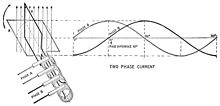Two-phase alternating current
In electrical engineering, two-phase alternating current , also known as a two-phase system , is a special form of two alternating currents or alternating voltages that are fixed in time . The two-phase alternating current, like the three-phase alternating current, is a form of multiphase alternating current , but only plays a subordinate role in electrical power engineering .
In the two-phase system - it is an asymmetrical two-phase system that is formed from a four-phase system by omitting two phases - the two sinusoidal alternating voltages are phase-shifted by 90 ° , as shown in the adjacent figure. This enables a rotating field to be generated and electrical machines such as the two-phase synchronous motor can be driven directly. As with the three-phase system, at least three conductors are required for the transmission of electrical energy; In the two-phase system, this results in poorer utilization of the available conductor cross-sections.

A two-phase alternating current can be obtained from the three-phase alternating current by means of the Scott circuit . Further possibilities are electronic inverters , especially for controlling two-phase synchronous motors .
Most stepper motors can also be thought of as two-phase motors .
The single-phase three-wire network for public power supply, which is particularly widespread in North America , is sometimes and incorrectly referred to as a two-phase system, even though it is a single-phase system in the basic installation.
literature
- Terrell Croft, Wilford Summers (ed): American Electricians' Handbook . 11th edition. McGraw Hill, New York 1987, ISBN 0-07-013932-6 , pp. 3–10, Figures 3–23 .
